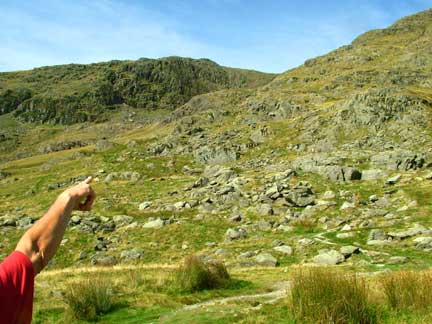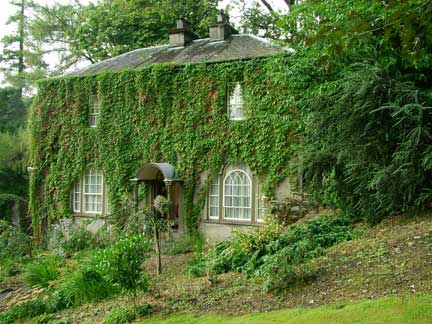
Just as the sky seemed about to open up with rain, a Grey Heron (Ardea cinerea) flew overhead and landed on the far side of the little bay on which I was standing. In spite of using my camera tripod, I could not get a good photo but offer this one just to have it represented.

The local people told me it was the only common heron in Britain and, according to my British bird book, it is. Just for the information of world-be birders, British and others, there are three other herons that put in rare appearances in Britain: Squacco Heron, Purple Heron, and Night Heron. The Green Heron is a very rare visitor to Britain.
Églantine took the easier walk this morning 8 ¼ miles with 875 feet of ascent. She walked under clouds most of the day but did not have any rain. I chose the harder walk of 8 ¾ miles with 2975 feet of ascent. All the walks started from a place called Langdale Pikes. We were let off the bus at a parking lot and started hiking down a road with high stonewalls on either side.

I have altered the photo below to show the route of the harder walk.

The narrow paved road is a farm lane that stops at the farmhouse that one can see, with a bit of imagination, at the end of the road. Leaving the farmstead, we walked up, and up to, what we were told was a magnificent view over Eskdale. Actually, we walked into clouds and could barely see each other at the top.

We hunkered down among and between rocks for a very quick lunch in drizzle and then started the return hike trying to stay in sight of each other as only the leader knew where we were or were going in the heavy fog. In spite of the fact that we were scrambling through large, wet, slippery boulders, we actually met three or four other walkers as we struggled along. Then the winds came. Sorry, no photos of the gale force winds. In addition to the winds, there was still the drizzle, wet rocks, and poor visibility to cope with. Because of needing to lean over a lot to see my footing due to my bifocal glasses, water collected on my lenses and then the winds swirled the water about so much that I got dizzy. An extra gust of wind helped take my dizzy body off its feet and down onto the rocks. It was probably a good thing that I could not see exactly where I was or it might have been even more frightening to be tossed about the mountainside by the high winds. During the next few minutes of fighting to move through the high winds, several other hikers went down also but, fortunately, no one was hurt and we were around a bend and out of the worst of the winds for the rest of the hike. It did make for an exciting quarter hour.
As the winds lifted, we found ourselves looking down on what looked like a huge, boiling cauldron. Actually it was a cloud filled tarn (small mountain lake).

Below is another view of the tarn from a lower level. I wish I could have captured the actual look of the swirling mists that circled around and over this small mountain lake. It was like a scene from the movie Lord of the Rings.

Having survived the gale force winds and the "boiling cauldron," the rest of the hike was rather anticlimactic. We walked out of the clouds to see the valley below and just had to amble along, another few miles downhill, to reach the pub before time to leave on the bus.

See the small clump of trees at the bottom left of the valley? The pub is just behind them out of sight.









































